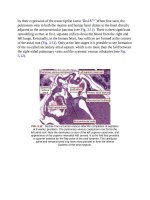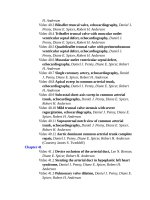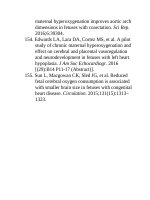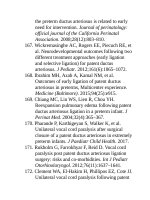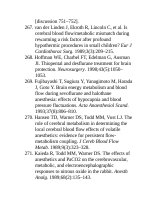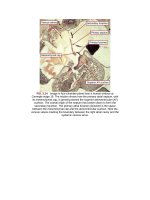Andersons pediatric cardiology 1856
Bạn đang xem bản rút gọn của tài liệu. Xem và tải ngay bản đầy đủ của tài liệu tại đây (83.81 KB, 3 trang )
tomakesurethattherearenocomplicationsofcannulation(e.g.,regurgitationof
thesystemicAVorsemilunarvalve),evaluateforresiduallesions,andmake
certainthatthesystemicventricleisdecompressed.Ifthereisdistentionandlack
ofejection,theventricleisunlikelytorecoverandplacementofaventshouldbe
stronglyconsidered.Cardiaccatheterizationwhilethepatientisonmechanical
supportishelpfultoexcluderesiduallesionsandperhapsperforminterventional
procedures,buthemodynamiccalculationsareextremelydifficulttomakeunder
theconditionsofECMO.Clinicalevidenceofventricularrecoveryincludesthe
returnofnormalsinusrhythmandspontaneouscardiacejection.Evidenceof
recoveryusuallyappearswithin1to4days.Ideallythepatientisweanedfrom
supportandobservedoneithernoorminimalflowforaperiodoftimeand,if
stable,hemodynamicsaremaintained;thendecannulationcanbeperformed.For
thepatientwithapartiallyoccludedshunt,theshuntwillhavetobereopened
priortoseparationfromECMO.
AcuteRespiratoryFailureAfterExtubation
Reintubationwithin24hoursofextubationfollowingneonatalpalliationfor
fUVHisnotuncommon,reachingashighas33%adecadeortwoago.More
recently,whilesomewhatimproved,itremainsat10%to20%.42,105,163Indeed,
tracheostomyusehasbeenreportedtobeashighas2%ofpatients(126of5721)
inonerecentseries.171Commoncausesofacuterespiratoryfailureafter
extubationincludeairwayedema,leftvocalcordinjury,andparalysisofthe
phrenicnerve.Investigationsfortheseproblemsaretypicallyundertaken
followingstabilizationandreintubation.Acutefailuretoextubate—aprimary
airwayandventilationissue—mustbeevaluateddifferentlythantheprogressive
cardiopulmonaryfailurediscussedearlier.
Injurytotherecurrentlaryngealnervewillresultinvocalcorddysfunction
(VCD).VCDafterpediatriccardiovascularsurgeryisassociatedwithineffective
cough,impairedclearanceofairwaysecretions,anddifficultyinmaintaining
lungvolume,whichcancontributetoearlyrespiratoryfailureafterextubation.
VCDcanresultinsignificantfeedingproblemsandahigherriskofaspiration.
Mostinjuriesinvolvetheleftrecurrentlaryngealnerveandcanoccurinupto
two-thirdsofpatientsundergoingarchproceduressuchastheNorwood
procedure.Managementincludesfeedingevaluationandamodifiedfeeding
regimensometimesincludingtheavoidanceoforalfeedswitheithera
nasogastrictubeorgastrostomytube.IntheNorwoodpopulation,VCDaddsto
lengthofstayintheCICU.RecoveryofVCDisseeninabout75%ofsurviving
patientsafterayear.172–174
Injurytothephrenicnervemayoccurduringcardiacsurgeryandwillresultin
paralysisofthediaphragm.Thisisacommoncauseoffailureofextubation.
Althoughphrenicnerveinjuryoccursatthetimeofsurgery,progressivemuscle
atrophyandlossoftonetakeseveraldaystodevelop;asaconsequence,the
patientmaybeextubatedandmayappearwelluntildiaphragmaticfunction
worsens.Eventuallyparadoxicmotionoftheparalyzeddiaphragmoccurs,
impairingrespiratorymechanics.Thepatientwilldeveloptachypnea,
hypercapnia,andaccessoryrespiratorymuscleuse.Thechestx-raywillshow
progressiveelevationoftheaffecteddiaphragm.Thediagnosiscanbeconfirmed
byultrasoundorfluoroscopy.Ultimatelythepatientmayneednoninvasive
ventilatorysupportorreintubationandmechanicalventilation.Although
recoveryofnerveanddiaphragmaticfunctioniscommon,thetimecourseis
typicallymonths,andfailuretoweanfromevennoninvasiverespiratorysupport
isagenerallyacceptedindicationfordiaphragmaticplication.Typically,a
seventhinterspaceposterolateralthoracotomyisperformedontheaffectedside.
Thediaphragmisplicatedwithaseriesofsutures.Theaimistocreateataut
diaphragmthatwillnotmoveparadoxicallyandwillpermitthecontralateral
healthydiaphragmtochangeintrathoracicvolumeandallowforeffective
ventilation.Mostpatientsbenefitfromplicationandcanbeextubatedwithina
dayortwooftheprocedure.Plicationdoesaffectultimatediaphragmatic
recovery.175–177
EvaluationandManagementofFailureto
Progress
Althoughcenter-specific,theprogressionofneonatesfollowingpalliationfor
univentricularheartdiseaseshouldgenerallyfollowapredictablepattern
dependingontheexactsurgicalprocedure,comorbidities,andpotentialsystemic
limitations.14,105Centersshouldestablishreliablebenchmarksforprogression
(e.g.,sternalclosure,weaningfromvasoactivemedications,timingof
extubation,progressiontofullenteralnutrition).Anydeviationfromthe
expectedcourseshouldpromptearlyinvestigation.Commonlyaccepted
deviationsfromthetypicalcoursearesummarizedinBox71.4.
Box71.4
CommonClinicalPresentationsof“Failureto
Progress”
■Persistentborderlinehemodynamics
■Persistenthypoxemia
■Persistentneedformechanicalventilation
■Persistentfluidoverload
■Inabilitytotoleratefullenteralnutrition
■Poorweightgain
Themostcommonreasonsforfailuretoprogressisaborderline
hemodynamicprofile,apersistentlowcardiacoutputstate,orhemodynamic
deteriorationuponextubation.Theseconditionsshouldtriggerprompt
evaluationclinicallybyechocardiographyand,ifnecessary,cardiac
catheterization.Ifthereisanysuspectedanatomicburdenorcoronary
abnormality,orifnoclearlyidentifiablecauseispresent,earlypostoperative
cardiaccatheterizationshouldbestronglyconsidered.Wehavefoundithelpful
toconveneamultidisciplinarydiscussionbetweenthecardiacsurgeon,cardiac
intensivecarephysician,imagingteam,andinterventionalcardiologistpriorto
anyplanneddiagnosticorinterventionalprocedure.Datasuggestthatearly
postoperativecatherizationyieldsimportantinformationregardingmodifiable
residualanatomicdisease,muchofwhichcanbetreatedduringthesame
catheterization178–180inmorethan70%ofcases.Despitehistoricalbiasestothe
contrary,earlycatheter-basedinterventionscanbeperformedwithminimal
complications.
Sometimeschronicrespiratoryfailureisthereasonforfailuretoprogress.
Failuretoweanfrominvasiveornoninvasivemechanicalventilationshouldfirst
promptathoroughinvestigationintoacardiacetiology;anyresiduallesions
shouldbeaddressedifpossible.Directlaryngoscopyofthevocalcords,trachea,
andbronchiisfrequentlyhelpfulevenifnormal.Fluoroscopyonsonographyof
thediaphragmduringspontaneousventilationshouldbeperformedforpatients
whofailtoweanfrommechanicalventilation;ifdiaphragmaticparalysisis
